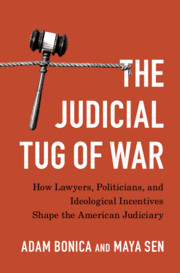 The Judicial Tug of War
The Judicial Tug of War Book contents
- Frontmatter
- Dedication
- Contents
- List of Figures
- List of Tables
- Acknowledgments
- 1 Introduction: The Tug of War Over the American Judiciary
- I The Legal Profession and the “Captured Judiciary”
- II Political Actors and the Incentive to Politicize
- III Ramifications of the Judicial Tug-of-War
- 7 The Politics of Judicial Reform
- 8 The Tug of War, Polarization, and Judicial Conflict
- 9 Conclusion: American Courts in Times of Increasing Polarization
- Bibliography
- Index
- Other Books in the Series
7 - The Politics of Judicial Reform
from III - Ramifications of the Judicial Tug-of-War
Published online by Cambridge University Press: 09 December 2020
- Frontmatter
- Dedication
- Contents
- List of Figures
- List of Tables
- Acknowledgments
- 1 Introduction: The Tug of War Over the American Judiciary
- I The Legal Profession and the “Captured Judiciary”
- II Political Actors and the Incentive to Politicize
- III Ramifications of the Judicial Tug-of-War
- 7 The Politics of Judicial Reform
- 8 The Tug of War, Polarization, and Judicial Conflict
- 9 Conclusion: American Courts in Times of Increasing Polarization
- Bibliography
- Index
- Other Books in the Series
Summary
As our discussion in Chapter 6 makes clear, how judges are selected shapes the power dynamics of the judicial tug of war. This makes judicial selection itself a source of heated conflict, the subject we take up in Chapter 7. We use our judicial tug-of-war framework to explore how the parties respond or try to change existing judicial selection mechanisms. Specifically, as we show, the greater the misalignment between the ideological preferences of attorneys and politicians, the greater the incentives political elites will have to introduce ideological considerations into the judicial selection process. Understanding this dynamic, we argue, is key to both explaining and predicting attempts at judicial reform: Under current ideological configurations, conservatives will, depending on how liberal they perceive the bar to be, back reform efforts oriented toward partisan elections and executive appointments, while liberals will work to maintain merit-oriented commissions. We explore the contours of this predictive framework with three illustrative case studies: Florida in 2001, Kansas in 2011, and North Carolina in 2016.
Keywords
- Type
- Chapter
- Information
- The Judicial Tug of WarHow Lawyers, Politicians, and Ideological Incentives Shape the American Judiciary, pp. 215 - 249Publisher: Cambridge University PressPrint publication year: 2020
